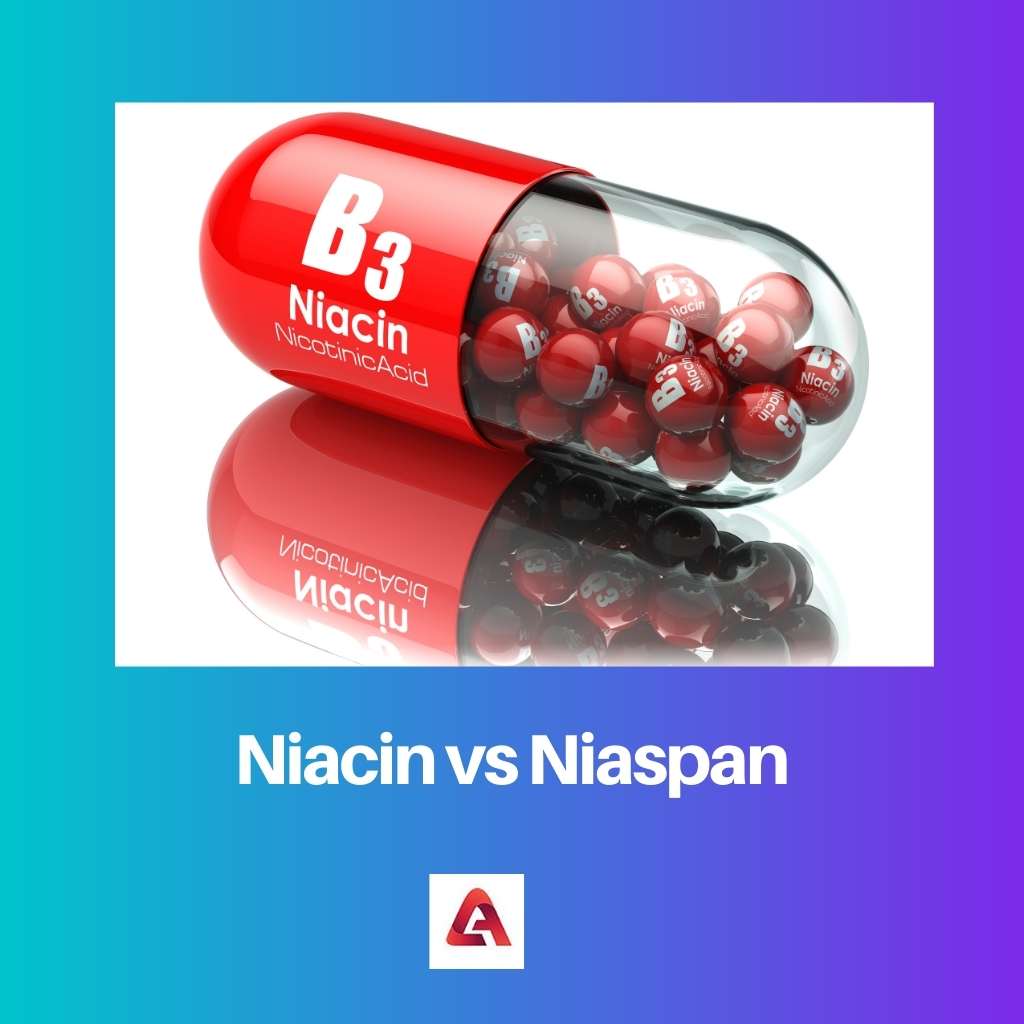Vitamins are essential micronutrients that aid the human body’s metabolism. Humans are unable to manufacture essential nutrients. As a result, it is required in the diet.
Vitamins are also connected to other compounds known as “Vitamers”. Vitamins help in the development of cellular components. Niacin and Niaspan are B vitamins that are found mostly in plants and animals.
Key Takeaways
- Niacin is a form of vitamin B3, while Niaspan is a prescription, extended-release version of niacin.
- Niaspan is used to treat high cholesterol and reduce the risk of heart disease, whereas niacin is available over the counter for various health purposes.
- Niaspan reduces the risk of flushing, a common side effect of niacin, due to its extended-release formulation.
Niacin vs Niaspan
Niacin is a generic drug with nicotinic acid from several drug manufacturers. This drug is used to reduce cholesterol levels in the bloodstream. Niaspan is a brand name for Niacin with extended-release technology. Abbott Laboratories is the main producer of this niacin supplement.

Niacin is an important vitamin produced by the protein tryptophan, which is derived from various living organisms. Niacin may be obtained from the diet by eating whole treated or boxed meals.
Foods like beef, chicken, and redfish like tuna and salmon, and also lower amounts of peanuts, beans, and grains. Niacin is effective as both a medicine and a food supplement.
Niaspan is a prescription medication used to decrease bad cholesterol or LDL (low-density lipoprotein) levels in the blood while increasing good cholesterol or HDL levels (high-density lipoprotein).
Niaspan can be taken alone or in combination with other drugs. Niaspan belongs to a class of medications known as lipid-lowering medicines, water-soluble vitamins, and B vitamins.
Comparison Table
| Parameters of Comparison | Niacin | Niaspan |
|---|---|---|
| Type | Generic Drug | Branded drug |
| Drug Release | Immediate | Slow Acting |
| Absorption | Less than 1 hour | 6 to 8 hours |
| Effects on Lipids | Yes | Yes although the effect is less intense when compared to Niacin. |
| Clinical Profile | High rates of flushing | Less flushing due to slow action |
| Daily Dosage | 500 mg | 1000 mg |
| Melting point | 237 °C | 129.5 °C |
| Usage | Niacin is a medication that is used to treat vitamin B deficiency as well as high triglycerides and chloride ions in the blood. | Niaspan is a medication that is used to increase the amount of good cholesterol in the body while decreasing the level of bad cholesterol in the blood. |
What is Niacin?
Niacin is a B vitamin that your system produces and uses to convert meals into fuel. It supports the wellness of your neurological system, digestive tract, and skin.
Niacin is frequently included in multivitamins, but most individuals receive sufficient niacin through their diet. Niacin is a nutrient as well as a type of vitamin. It is regarded as a vital dietary supplement.
In the USA, niacin is available only via prescription. Niacin is a substrate for two enzymes. These two enzymes aid in the body’s catabolic and anabolic reactions.
Niacin is used to address a variety of cholesterol issues as well as a deficient condition known as Pellagra. Because of the massive dosages administered every day, Niacin has a significant influence on a patient’s triglycerides and high cholesterol.
Aside from Pellagra, niacin deficiency can induce diarrhoea, dermatitis, skin thickening, hyperpigmentation, inflammation of the lips and tongue, delirium, dementia, and death.
Some of the most frequent symptoms of niacin deficiency are irritability, weariness, apathy, memory loss, restlessness, poor focus, anxiety, and melancholy.
Niacin deficiency is more common in developing nations than in developed ones. It is frequently associated with starvation, drunkenness, poverty, and other factors.
People who use maize as a staple meal may suffer from niacin insufficiency. Because it is the only meal that has a low niacin content.
Hartnup illness, which is linked to niacin, is characterised by a failure to accept the amino acid tryptophan.
What is Niaspan?
Niaspan is used in conjunction with a balanced diet and workout plan to help lower “negative” cholesterol and lipids while increasing “healthy” cholesterol within your bloodstream.
It is used when non-drug therapies has failed to effectively decrease cholesterol.
Niaspan can be used in combination with or without other drugs. Reducing “negative” cholesterol whilst boosting “healthy” cholesterol aids in the prevention of cardiovascular events.
Lowering fat intake may also help minimise the risk of pancreatic issues (pancreatitis) in people who are predisposed to them.
In complement to following a proper diet that includes low cholesterol, other lifestyle changes that may help this medicine perform better comprise exercising, losing body-weight if obese, and avoiding tobacco.
You must consult your physician for additional advice. Take this drug orally as instructed by your pharmacist, at night, with a low-fat dinner or appetizer.
Taking Niaspan on an empty belly raises the likelihood of negative consequences (such as flushing and an upset stomach). Crushing or chewing slow-releasing tablets is not recommended.
As a consequence, the drugs may be delivered together at once, increasing the possibility of side reactions. Also, do not break the pills without the consultation of your doctor.
Consume the complete or split tablet whole, without breaking or grinding.
Main Differences Between Niacin and Niaspan
- Niacin is a generic medication, but Niaspan is a brand-name medication.
- Niacin is available in both quick and slow-release forms, and Niaspan includes an extended-release mechanism.
- Niacin has a disadvantage in terms of face flushing due to its fast-release composition, whereas Niaspan does not.
- Niacin is used alone, without any additional ingredients, although Niaspan is occasionally combined with other parts of the diet or other medications.
- Niacin can induce liver damage by causing saturation. However, Niaspan’s slow-acting composition allows Niacin to be administered gradually, eliminating the occurrence that might cause liver damage.
- https://www.sciencedirect.com/science/article/pii/S0026049598902840
- https://www.sciencedirect.com/science/article/pii/S0002914900014715
- https://www.sciencedirect.com/science/article/pii/S1933287407002826
